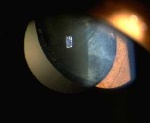| Differential
Diagnosis
of Physical Signs in Lens |
 |
| Differential
Diagnosis
of Physical Signs in Lens |
 |
In the clinical examination, cataract is often encountered but it is unlikely to be the only physical sign. It is either coincidental or related to the underlying main condition that the examiner expect you to detect (for example; penetrating eye injuries, Fuch's heterochromic cylitis and diabetic mellitus). The lens should be examined with retroillumination (to detect anterior and posterior subcapsular opacities) and direct focal slit illumination (to detect opacity in different zones of the lens).
The only lens condition that may present as the main case is lens subluxation and usually the patient has signs of Marfan's syndrome.
Cataract
(Cataract can be classified according to the aetiology or to the zones involved. The following is a list of cataract according to aetiology following by a list for causes for posterior subcapsular cataract)
Causes of posterior subcapsular cataract (posterior subcapsular cataract may be easily missed if you do not examine the lens carefully with direct focal slit-lamp illumination)
- Congenital
hereditary
associated with ocular disease such as PHPV
associated with systemic disease such as congenital rubella or galactosaemia- Developmental defects
lens colobomas
ectopia lentis
lenticonus
lentiglobus- Age-related cataracts
- Metabolic and toxic cataract
diabetes mellitus
drugs such as chlorpromazine and steroids- Radiation
- Traumatic cataracts
- Following ocular inflammation
- Other: myotonic dystrophy
drug-induced such as steroids chronic inflammation posterior segment diseases such as retinitis pigmentosa or high myopia neurofibromatosis type II diabetes mellitus age-related Lens subluxation
(In cases of lens subluxation, the eyes are often dilated for easy examination. In undilated eye, the presence of iridodonosis, phacodonesis, deep anterior chamber and presence of vitreous in the anterior chamber should raise your suspicion. The most common case in the examination is Marfan's syndrome and you may be asked to look for associated physical signs. The other common case is pseudoexfoliation syndrome.
Always mention to the examiner the direction of the subluxation as one of the favourite questions amongst the examiners is the differences between Marfan's syndrome and homocystinuria. )
- Congenital
congenital glaucoma
aniridia- Systemic syndromes
Marfan
Weill-Marchesani's syndrome
Ehlers-Danlos syndrome
Osteogenesis imperfecta- Metabolic disorders
homocystineuria
hyperlysinaemia- Trauma